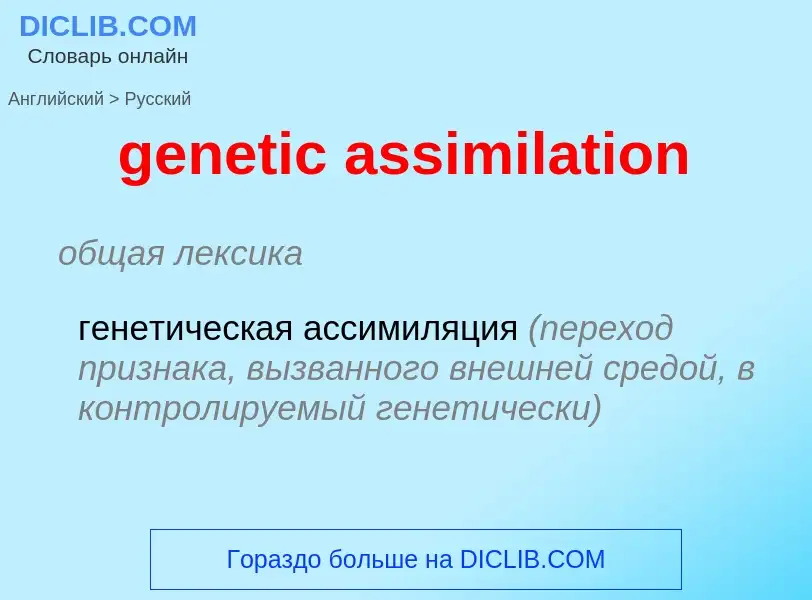Tradução e análise de palavras por inteligência artificial ChatGPT
Nesta página você pode obter uma análise detalhada de uma palavra ou frase, produzida usando a melhor tecnologia de inteligência artificial até o momento:
- como a palavra é usada
- frequência de uso
- é usado com mais frequência na fala oral ou escrita
- opções de tradução de palavras
- exemplos de uso (várias frases com tradução)
- etimologia
genetic assimilation - tradução para russo
общая лексика
генетическая ассимиляция (переход признака, вызванного внешней средой, в контролируемый генетически)
общая лексика
прикладная генетика
Definição
Wikipédia
Genetic assimilation is a process described by Conrad H. Waddington by which a phenotype originally produced in response to an environmental condition, such as exposure to a teratogen, later becomes genetically encoded via artificial selection or natural selection. Despite superficial appearances, this does not require the (Lamarckian) inheritance of acquired characters, although epigenetic inheritance could potentially influence the result. Waddington stated that genetic assimilation overcomes the barrier to selection imposed by what he called canalization of developmental pathways; he supposed that the organism's genetics evolved to ensure that development proceeded in a certain way regardless of normal environmental variations.
The classic example of genetic assimilation was a pair of experiments in 1942 and 1953 by Waddington. He exposed Drosophila fruit fly embryos to ether, producing an extreme change in their phenotype: they developed a double thorax, resembling the effect of the bithorax gene. This is called a homeotic change. Flies which developed halteres (the modified hindwings of true flies, used for balance) with wing-like characteristics were chosen for breeding for 20 generations, by which point the phenotype could be seen without other treatment.
Waddington's explanation has been controversial, and has been accused of being Lamarckian. More recent evidence appears to confirm the existence of genetic assimilation in evolution; in yeast, when a stop codon is lost by mutation, the reading frame is preserved much more often than would be expected.

![''[[Notechis scutatus]]'' tiger snakes from islands, like this one from Chappell Island, have larger heads than mainland populations, apparently genetically assimilated.<ref name=AubretShine2009/> ''[[Notechis scutatus]]'' tiger snakes from islands, like this one from Chappell Island, have larger heads than mainland populations, apparently genetically assimilated.<ref name=AubretShine2009/>](https://commons.wikimedia.org/wiki/Special:FilePath/Chappell Island tiger snake.jpg?width=200)
![Normal and cross-veinless ''[[Drosophila]]'' wings Normal and cross-veinless ''[[Drosophila]]'' wings](https://commons.wikimedia.org/wiki/Special:FilePath/Drosophile normale et cross-veinless.jpg?width=200)

![''[[A. tumefaciens]]'' attaching itself to a carrot cell ''[[A. tumefaciens]]'' attaching itself to a carrot cell](https://commons.wikimedia.org/wiki/Special:FilePath/Agrobacterium-tumefaciens.png?width=200)

![Human cells in which some proteins are fused with [[green fluorescent protein]] to allow them to be visualised Human cells in which some proteins are fused with [[green fluorescent protein]] to allow them to be visualised](https://commons.wikimedia.org/wiki/Special:FilePath/Expression of Human Wild-Type and P239S Mutant Palladin.png?width=200)
![A gene gun uses [[biolistics]] to insert DNA into plant tissue. A gene gun uses [[biolistics]] to insert DNA into plant tissue.](https://commons.wikimedia.org/wiki/Special:FilePath/Genegun.jpg?width=200)
![In 1974 [[Rudolf Jaenisch]] created a [[genetically modified mouse]], the first GM animal. In 1974 [[Rudolf Jaenisch]] created a [[genetically modified mouse]], the first GM animal.](https://commons.wikimedia.org/wiki/Special:FilePath/Jaenisch 2003 by Sam Ogden.jpg?width=200)
![[[Polymerase chain reaction]] is a powerful tool used in [[molecular cloning]]. [[Polymerase chain reaction]] is a powerful tool used in [[molecular cloning]].](https://commons.wikimedia.org/wiki/Special:FilePath/Master Mix with Primers form PCR.jpg?width=200)
![Knockout mice]] Knockout mice]]](https://commons.wikimedia.org/wiki/Special:FilePath/PCWmice1.jpg?width=200)
